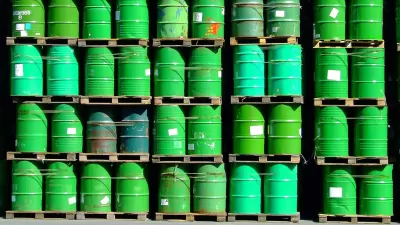The short answer is yes, according to this NPR report that includes interviews with energy experts. The boom in shale fracking for oil and natural gas and the zeal of small energy companies is to credit. But UC Berkeley's Don Kammen has his doubts.
John Ydstie presents a surprisingly optimistic forecast from some experts.
"Energy self-sufficiency is now in sight," says energy economist Phil Verleger. He believes that within a decade, the U.S. will no longer need to import crude oil and will be a natural gas exporter. It's not the result of government policy or drilling by big oil...but small energy companies using such controversial techniques as hydraulic fracturing, along with horizontal drilling, unlocking vast oil and natural gas deposits".
In agreement is Amy Myers Jaffe, of Rice University's Baker Institute.
Considering that according to the Energy Information Agency, "the United States imported about 49% of the petroleum... that we consumed during 2010", Verleger's forecast might seem unreasonably optimistic.
Another expert interviewed, while agreeing with Verleger, uses the term "energy security" rather than independence "because most oil imports will come from Canada, not unstable places like the Middle East."
Also interviewed is Dan Kammen, a professor in the energy and resource group at the University of California, Berkeley, who would prefer to see increased use of renewable sources of energy rather than increased mining of domestic fossil fuels.
Not reported is the often quoted factoid that "America owns 3 percent of the world's oil but consumes 25 percent of its global reserves" (Rep. Gerry Connolly, House floor speech, May 3, 2011). In fact, according to Truth-O-Meter of the Tampa Bay Times, it's 1.5% and 22%, respectively.
FULL STORY: Is U.S. Energy Independence Finally Within Reach?

Maui's Vacation Rental Debate Turns Ugly
Verbal attacks, misinformation campaigns and fistfights plague a high-stakes debate to convert thousands of vacation rentals into long-term housing.

Planetizen Federal Action Tracker
A weekly monitor of how Trump’s orders and actions are impacting planners and planning in America.

In Urban Planning, AI Prompting Could be the New Design Thinking
Creativity has long been key to great urban design. What if we see AI as our new creative partner?

King County Supportive Housing Program Offers Hope for Unhoused Residents
The county is taking a ‘Housing First’ approach that prioritizes getting people into housing, then offering wraparound supportive services.

Researchers Use AI to Get Clearer Picture of US Housing
Analysts are using artificial intelligence to supercharge their research by allowing them to comb through data faster. Though these AI tools can be error prone, they save time and housing researchers are optimistic about the future.

Making Shared Micromobility More Inclusive
Cities and shared mobility system operators can do more to include people with disabilities in planning and operations, per a new report.
Urban Design for Planners 1: Software Tools
This six-course series explores essential urban design concepts using open source software and equips planners with the tools they need to participate fully in the urban design process.
Planning for Universal Design
Learn the tools for implementing Universal Design in planning regulations.
planning NEXT
Appalachian Highlands Housing Partners
Mpact (founded as Rail~Volution)
City of Camden Redevelopment Agency
City of Astoria
City of Portland
City of Laramie




























